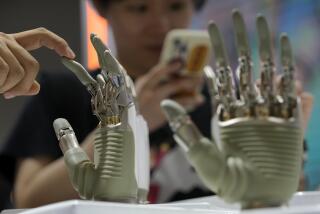Asset Values Shifting as Firms Begin to Account for Employee Brainpower
- Share via
To invoke an unfortunate buzz phrase, a paradigm shift has occurred in corporate America. Farewell, Industrial Age. Hello, Information Age.
No longer is a firm’s worth measured by bricks, mortar and machinery. Nowadays, as corporations are fond of saying, the real asset is intellectual capital--also known as employee brainpower. More important than cash and real estate is an organization’s ability to generate ideas and devise products and services that keep it on the cutting edge.
Unfortunately for would-be stockholders, there is no line item in a financial statement where they can learn the “value” of the knowledge contained in a company’s cubicles and conference rooms. Knowledge and creativity are intangibles, after all, and the Financial Accounting Standards Board offers no rules for measuring them.
But a movement is afoot to develop ways to put a formal value on knowledge. In many ways, proponents say, it would be akin to corporate “goodwill,” the often lofty value assigned to such intangibles as brand identity, image and reputation when one company is acquired by another.
The idea of measuring knowledge has already gained favor at a number of leading Scandinavian companies--notably Skandia, a Swedish insurance and financial services outfit. For the last few years, Skandia has included a supplement to its annual report highlighting efforts to create value by developing employees’ careers. Skandia even has a director of intellectual capital.
*
Karl Erik Sveiby, a Swedish businessman and consultant who now lives in Brisbane, Australia, helped pioneer the concept in Europe and is spreading the gospel through his book “The New Organizational Wealth: Managing & Measuring Knowledge-Based Assets” (Berrett-Koehler Publishers). It opens with a chapter on “The New Wealth: Intangible Assets” and offers up Microsoft, the world’s largest computer software company, as an example. Shares in Microsoft, Sveiby notes, changed hands at an average price of $70 during 1995, when their so-called book value was just $7. Put another way, “for every $1 of recorded value, the market saw $9 in additional value for which there was no corresponding record in Microsoft’s balance sheet.”
What mysterious, highly productive asset did Microsoft possess that, say, Ford Motor and Bethlehem Steel lacked? Basically, knowledge--and the ability to share and transfer that knowledge so that it could be parlayed into vastly higher profits and wealth for investors. Yet the balance sheet itself, an Industrial Age legacy, revealed no clue.
At countless management seminars and conferences in recent months, how to manage knowledge and measure intellectual capital have replaced re-engineering as the topics du jour. But nobody has figured out how to measure know-how, and accounting firms are loath to even try, given how often they’re sued over valuations of much more tangible elements.
“There are great companies struggling with this,” says Kimball Fisher, who heads Fisher Group, a Portland, Ore., consulting firm that works with Fortune 100 companies.
Such a shift could dramatically change the behavior of corporate leaders. They would, Fisher says, focus more on “how they treat people instead of stuff.” Rather than view individuals as expensive liabilities, they would get listed in the asset column. By extension, mass layoffs would no longer be rewarded on Wall Street.
*
Eighteen months ago, Hewlett-Packard’s Professional Services Organization, a 5,000-person consulting unit with offices worldwide, launched a knowledge initiative. The idea, says project co-leader Marilyn Martiny, was “to make the knowledge of the few the knowledge of the many.”
With the help of outside consultants, she and colleague Peggy Parskey are looking for ways to reward employees who share knowledge to help cut down the time required to develop solutions for customers.
“In the past,” Parskey says, “individual, Herculean types of activities have been rewarded.” Now the unit general manager asks of employees with good ideas: “Whom have you shared this with?”
The HP unit is studying five components of intellectual capital: the capabilities and skills of its workers; the methodologies, strategies and solutions its consultants use with clients; experience and positive relationships with customers; image in the marketplace; and the day-to-day culture of the organization. One thing the company has learned so far is that “these things are not easy to measure,” Parskey says.
And why even bother, some critics wonder. Given the bewildering pace of change, it would be nuts to attempt to assign a dollar figure to intellectual capital, says Tom Davenport, a professor at the University of Texas graduate business school. “The feasibility quotient is somewhere near zero.”
John Peetz, the Los Angeles-based chief knowledge officer of accounting and consulting firm Ernst & Young, agrees. “In our business,” he says, “content and human resources can’t be separated out. Content without skilled people probably is not worth anything.”
Does your company have a creative approach to measuring brainpower? Tell us about it. Write to Martha Groves, Corporate Currents, Business Section, Los Angeles Times, Times Mirror Square, Los Angeles, CA 90034. Or e-mail [email protected]
More to Read
Inside the business of entertainment
The Wide Shot brings you news, analysis and insights on everything from streaming wars to production — and what it all means for the future.
You may occasionally receive promotional content from the Los Angeles Times.











